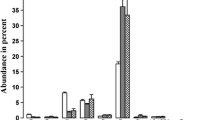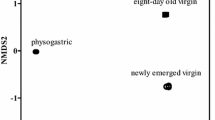Summary
Cuticular hydrocarbons were extracted from sixty individual workers from six colonies ofVespa crabro L. and analyzed by combined gas-chromatography/mass spectrometry. Discriminant analysis of the cuticular hydrocarbon profiles of workers and queens showed that the wasps could be grouped by colony and by caste. Stepwise discriminant analysis selected the components which were weighted most heavily in these analyses. Different combinations of cuticular hydrocarbons were important in grouping workers by colony, queens and workers by colony, and workers and queens by caste.
Similar content being viewed by others
References
Akre, R. D. and H. C. Reed, 1984. Vespine defense. In:Defensive Mechanisms in Social Insects (H. R. Hermann (Ed.)), Praeger Publishers, New York. pp. 59–94.
Blomquist, G. J. and J. W. Dillwith, 1985. Cuticular lipids. In:Comprehensive Insect Physiology, Biochemistry and Pharmacology, Vol. 3. Integument, Respiration and Circulation (G. A. Kerkut and L. I. Gilbert (Eds.)), Pergamon, Oxford, U.K. pp. 117–154.
Blomquist, G. J., D. R. Nelson and M. de Renobales, 1987. Chemistry, biochemistry, and physiology of insect cuticular lipids.Arch. Insect Biochem. Physiol. 6:227–265.
Bonavita-Cougourdan, A., J. L. Clément and C. Lange, 1987. Nestmate recognition: the role of cuticular hydrocarbons in the antCamponotus vagus Scop.J. Entomol. Sci. 22:1–10.
Bonavita-Cougourdan, A., G. Theraulaz, A. G. Bagnères, M. Roux, M. Pratte, E. Provost and J.-L. Clément, 1991. Cuticular hydrocarbons, social organization and ovarian development in a Polistine wasp:Polistes dominulus Christ.Comp. Biochem. Physiol. 100B:667–680.
Breed, M. D. and G. E. Julian, 1992. Do simple rules apply in honey-bee nestmate discrimination?Nature 357:685–686.
Brill, J. H., T. Mar, H. T. Mayfield and W. Bertsch, 1986. Application of computer-based pattern recognition procedures in the study of biological samples. Comparison of the cuticular hydrocarbon profiles of different colonies of the black imported fire ant.Analyst 111:711–716.
Butler, C. G., D. J. C. Fletcher and D. Watler, 1969. Nest-entrance marking with pheromones by the honeybee,Apis mellifera L., and by a wasp,Vespula vulgaris L.Anim. Behav. 17:142–147.
Butts, D. P., M. A. Camann and K. E. Espelie, 1993. Discriminant analysis of cuticular hydrocarbons of the baldfaced hornet,Dolichovespula maculata (Hymenoptera: Vespidae).Sociobiology 21:193–201.
Butts, D. P., K. E. Espelie and H. R. Hermann, 1991. Cuticular hydrocarbons of four species of social wasps in the subfamily Vespinae:Vespa crabro L.,Dolichovespula maculata (L.),Vespula squamosa (Drury), andVespula maculifrons (Buysson).Comp. Biochem. Physiol. 99B:87–91.
Espelie, K. E. and E. A. Bernays, 1989. Diet-related differences in the cuticular lipids ofManduca sexta larvae.J. Chem. Ecol. 15:2003–2017.
Espelie, K. E., E. A. Bernays and J. J. Brown, 1991. Plant and insect cuticular lipids serve as behavioral cues for insects.Arch. Insect Biochem. Physiol. 17:223–233.
Espelie, K. E., G. J. Gamboa, T. A. Grudzien and E. A. Bura, 1994. Cuticular hydrocarbons of the paper wasp,Polistes fuscatus: a search for recognition pheromones.J. Chem. Ecol. 20:1677–1687.
Espelie, K. E. and H. R. Hermann, 1988. Congruent cuticular hydrocarbons: biochemical convergence of a social wasp, an ant and a host plant.Biochem. Syst. Ecol. 16:233–235.
Espelie, K. E. and H. R. Hermann, 1990. Suface lipids of the social waspPolistes annularis (L.) and its nest and nest pedicel.J. Chem. Ecol. 16:1841–1852.
Espelie, K. E., J. W. Wenzel and G. Chang, 1990. Surface lipids of social waspPolistes metricus Say and its nest and nest pedicel and their relation to nestmate recognition.J. Chem. Ecol. 16:2229–2241.
Ferguson, I. D., G. J. Gamboa and J. K. Jones, 1987. Discrimination between natal and non-natal nests by the social waspsDolichovespula maculata andPolistes fuscatus (Hymenoptera: Vespidae).J. Kansas Entomol. Soc. 60:65–69.
Gamboa, G. J., H. K. Reeve and D. W. Pfennig, 1986. The evolution and ontogeny of nestmate recognition in social wasps.Annu. Rev. Entomol. 31:431–454.
Getz, W. M. and R. E. Page Jr., 1991. Chemosensory kin-communication systems and kin recognition in honey bees.Ethology 87:298–315.
Hadley, N. F., 1985.The Adaptive Role of Lipids in Biological Systems, Wiley-Interscience, New York, 319 pp.
Howard, R. W., 1993. Cuticular hydrocarbons and chemical communication. In:Insect Lipids. Chemistry, Biochemistry and Biology (D. W. Stanley-Samuelson and D. R. Nelson, Eds.), University of Nebraska Press, Lincoln, Nebraska, pp. 179–226.
Howard, R. W. and G. J. Blomquist, 1982. Chemical ecology and biochemistry of insect hydrocarbons.Annu. Rev. Entomol. 27:149–172.
Howard, R. W., R. D. Akre and W. B. Garnett, 1990. Chemical mimicry in an obligate predator of carpenter ants (Hymenoptera: Formicidae).Ann. Entomol. Soc. Am. 83:607–616.
Howard, R. W., C. A. McDaniel and G. J. Blomquist, 1980. Chemical mimicry as an integrating mechanism: cuticular hydrocarbons of a termitophile and its host.Science 210:431–433.
Howard, R. W., C. A. McDaniel, D. R. Nelson, G. J. Blomquist, L. T. Gelbaum and L. H. Zalkow, 1982. Cuticular hydrocarbons ofReticulitermes virginicus (Banks) and their role as potential species- and caste recognition cues.J. Chem. Ecol. 8:1227–1239.
Jaisson, P., 1991. Kinship and fellowship in ants and social wasps. In:Kin Recognition (P. G. Hepper (Ed.)), Cambridge University Press, Cambridge, U.K. pp. 60–93.
Lachenbruch, P. A., 1975.Discriminant Analysis, Hafner Press, New York, 127 pp.
Layton, J. M., M. A. Camann and K. E. Espelie, 1994. Cuticular lipid profiles of queens, workers and males of the social waspPolistes metricus Say are colony-specific,J. Chem. Ecol. 20:2307–2321.
Layton, J. M. and K. E. Espelie, 1994. Effects of nest paper hydrocarbons on nest and nestmate recognition in colonies ofPolistes metricus Say.J. Insect Behav. (in press).
Lockey, K. H., 1988. Lipids of the insect cuticle: origin, composition and function.Comp. Biochem. Physiol. 89B:595–645.
Lorenzi, M. C., 1992. Epicuticular hydrocarbons ofPolistes biglumis bimaculatus (Hymenoptera Vespidae): preliminary results.Ethol. Ecol. Evol. 2:61–63.
Matsuura, M., 1991.Vespa andProvespa. In:The Social Biology of Wasps (K. G. Ross and R. W. Matthews (Eds.)), Cornell University Press, Ithaca, New York. pp. 232–262.
Nelson, D. R., 1978. Long-chain methyl-branched hydrocarbons: occurrence, biosynthesis and function.Adv. Insect Physiol. 13:1–33.
Ross, K. G., 1983. Laboratory studies of the mating biology of the eastern yellowjacket,Vespula maculifrons (Hymenoptera: Vespidae).J. Kansas Entomol. Soc. 56:523–537.
Ryan, R. E., T. J. Cornell and G. J. Gamboa, 1985. Nestmate recognition in the bald-faced hornet,Dolichovespula maculata (Hymenoptera: Vespidae).Z. Tierpsychol. 69:19–26.
SAS Institute, Inc., 1985.SAS User's Guide: Statistics, Version 5 Edition. SAS Institute, Cary, North Carolina.
Singer, T. L. and K. E. Espelie, 1992. Social wasps use nest paper hydrocarbons for nestmate recognition.Anim. Behav. 44:63–68.
Singer, T. L. M. A. Camann and K. E. Espelie, 1992. Discriminant analysis of cuticular hydrocarbons of social waspPolistes exclamans Viereck and surface hydrocarbons of its nest paper and pedicel.J. Chem. Ecol. 18:785–797.
Smith, B. H. and M. D. Breed, 1994. The chemical basis for nestmate recognition and mate discrimination in social insects. In:Chemical Ecology of Insects. II. (R. T. Cardé and W. J. Bell (Eds.)), Chapman and Hall, New York (in press).
Statistical Sciences, Inc., 1989.S-plus version 2.2, Release 1 for Sun 4 systems, Statistical Sciences, Inc., Seattle, WA.
Statistical Sciences, Inc., 1990.S-plus Reference Manual, Statistical Sciences, Inc., Seattle, WA.
Vander Meer, R. K., D. P. Jouvenaz and D. P. Wojcik, 1989a. Chemical mimicry in a parasitoid (Hymenoptera: Eucharitidae) of fire ants (Hymenoptera: Formicidae).J. Chem. Ecol. 15:2247–2261.
Vander Meer, R. K., D. Saliwaanchik and B. Lavine, 1989b. Temporal changes in colony cuticular hydrocarbon patterns ofSolenopsis invicta: implications for nestmate recognition.J. Chem. Ecol. 15:2115–2125.
Vander Meer, R. K. and D. P. Wojcik, 1982. Chemical mimicry in the myrmecophilous beetleMyrmecaphodius excavatacollis.Science 218:806–808.
Yang, G., B. R. Wiseman and K. E. Espelie, 1992. Cuticular lipids from silks of seven corn genotypes and their effect on development of corn earworm larvae [Helicoverpa zea (Boddie)].J. Agric. Food Chem. 40:1058–1061.
Author information
Authors and Affiliations
Rights and permissions
About this article
Cite this article
Butts, D.P., Camann, M.A. & Espelie, K.E. Workers and queens of the European hornetVespa crabro L. have colony-specific cuticular hydrocarbon profiles (Hymenoptera: Vespidae). Ins. Soc 42, 45–55 (1995). https://doi.org/10.1007/BF01245698
Received:
Revised:
Accepted:
Issue Date:
DOI: https://doi.org/10.1007/BF01245698




